Avanafil
Editor-In-Chief: C. Michael Gibson, M.S., M.D. [1]; Associate Editor(s)-in-Chief: Kiran Singh, M.D. [2]
Disclaimer
WikiDoc MAKES NO GUARANTEE OF VALIDITY. WikiDoc is not a professional health care provider, nor is it a suitable replacement for a licensed healthcare provider. WikiDoc is intended to be an educational tool, not a tool for any form of healthcare delivery. The educational content on WikiDoc drug pages is based upon the FDA package insert, National Library of Medicine content and practice guidelines / consensus statements. WikiDoc does not promote the administration of any medication or device that is not consistent with its labeling. Please read our full disclaimer here.
Overview
Avanafil is an erectile dysfunction agent that is FDA approved for the treatment of erectile dysfunction. Common adverse reactions include headache, flushing, nasal congestion, nasopharyngitis, back pain.
Adult Indications and Dosage
FDA-Labeled Indications and Dosage (Adult)
Indications
- Avanafil is a phosphodiesterase 5 (PDE5) inhibitor indicated for the treatment of erectile dysfunction
Dosage
Erectile Dysfunction
- The recommended starting dose is 100 mg. Avanafil should be taken orally as needed as early as approximately 15 minutes before sexual activity.
- Based on individual efficacy and tolerability, the dose may be increased to 200 mg taken as early as approximately 15 minutes before sexual activity, or decreased to 50 mg taken approximately 30 minutes before sexual activity. The lowest dose that provides benefit should be used.
- The maximum recommended dosing frequency is once per day. Sexual stimulation is required for a response to treatment.
Concomitant Medications
Alpha-Blockers
- If avanafil is co-administered with an alpha-blocker, patients should be stable on alpha-blocker therapy prior to initiating treatment with avanafil, and avanafil should be initiated at the 50 mg dose.
CYP3A4 Inhibitors
- For patients taking concomitant strong CYP3A4 inhibitors (including ketoconazole, ritonavir, atazanavir, clarithromycin, indinavir, itraconazole, nefazodone, nelfinavir, saquinavir, and telithromycin), do not use avanafil.
- For patients taking concomitant moderate CYP3A4 inhibitors (including erythromycin, amprenavir, aprepitant, diltiazem, fluconazole, fosamprenavir, and verapamil), the maximum recommended dose of avanafil is 50 mg, not to exceed once every 24 hours
DOSAGE FORMS AND STRENGTHS
- Avanafil is supplied as oval, pale yellow tablets containing 50 mg, 100 mg, or 200 mg avanafil debossed with dosage strength.
Off-Label Use and Dosage (Adult)
Guideline-Supported Use
There is limited information regarding Off-Label Guideline-Supported Use of Avanafil in adult patients.
Non–Guideline-Supported Use
There is limited information regarding Off-Label Non–Guideline-Supported Use of Avanafil in adult patients.
Pediatric Indications and Dosage
FDA-Labeled Indications and Dosage (Pediatric)
There is limited information regarding FDA-Labeled Use of Avanafil in pediatric patients.
Off-Label Use and Dosage (Pediatric)
Guideline-Supported Use
There is limited information regarding Off-Label Guideline-Supported Use of Avanafil in pediatric patients.
Non–Guideline-Supported Use
There is limited information regarding Off-Label Non–Guideline-Supported Use of Avanafil in pediatric patients.
Contraindications
Nitrates
- Administration of avanafil with any form of organic nitrates, either regularly and/or intermittently, is contraindicated. Consistent with its known effects on the nitric oxide/cyclic guanosine monophosphate (cGMP) pathway, avanafil has been shown to potentiate the hypotensive effects of nitrates.
- In a patient who has taken avanafil, where nitrate administration is deemed medically necessary in a life-threatening situation, at least 12 hours should elapse after the last dose of avanafil before nitrate administration is considered. In such circumstances, nitrates should only be administered under close medical supervision with appropriate hemodynamic monitoring.
Hypersensitivity Reactions
- Avanafil is contraindicated in patients with a known hypersensitivity to any component of the tablet. Hypersensitivity reactions have been reported, including pruritis and eyelid swelling.
Warnings
- Evaluation of erectile dysfunction (ED) should include an appropriate medical assessment to identify potential underlying causes, as well as treatment options.
- Before prescribing avanafil, it is important to note the following:
Cardiovascular Risks
- There is a potential for cardiac risk during sexual activity in patients with pre-existing cardiovascular disease. Therefore, treatments for ED, including avanafil, should not be used in men for whom sexual activity is inadvisable because of their underlying cardiovascular status.
- Patients with left ventricular outflow obstruction (e.g., aortic stenosis, idiopathic hypertrophic subaortic stenosis) and those with severely impaired autonomic control of blood pressure can be particularly sensitive to the actions of vasodilators, including avanafil.
- The following groups of patients were not included in clinical safety and efficacy trials for avanafil, and therefore until further information is available, avanafil is not recommended for the following groups:
- Patients who have suffered a myocardial infarction, stroke, life-threatening arrhythmia, or coronary revascularization within the last 6 months;
- Patients with resting hypotension (blood pressure less than 90/50 mmHg) or hypertension (blood pressure greater than 170/100 mmHg);
- Patients with unstable angina, angina with sexual intercourse, or New York Heart Association Class 2 or greater congestive heart failure.
- As with other PDE5 inhibitors avanafil has systemic vasodilatory properties and may augment the blood pressure-lowering effect of other anti-hypertensive medications. avanafil 200 mg resulted in transient decreases in sitting blood pressure in healthy volunteers of 8.0 mmHg systolic and 3.3 mmHg diastolic, with the maximum decrease observed at 1 hour after dosing. While this normally would be expected to be of little consequence in most patients, prior to prescribing avanafil, physicians should carefully consider whether patients with underlying cardiovascular disease could be affected adversely by such vasodilatory effects, especially in combination with sexual activity.
Concomitant Use of CYP3A4 Inhibitors
- Avanafil metabolism is principally mediated by the CYP450 isoform 3A4 (CYP3A4). Inhibitors of CYP3A4 may reduce avanafil clearance and increase plasma concentrations of avanafil.
- For patients taking concomitant strong CYP3A4 inhibitors (including ketoconazole, ritonavir, atazanavir, clarithromycin, indinavir, itraconazole, nefazodone, nelfinavir, saquinavir, and telithromycin), do not use avanafil.
- For patients taking concomitant moderate CYP3A4 inhibitors (including erythromycin, amprenavir, aprepitant, diltiazem, fluconazole, fosamprenavir, and verapamil), the maximum recommended dose of avanafil is 50 mg, not to exceed once every 24 hours.
Prolonged Erection
- Prolonged erection greater than 4 hours and priapism (painful erections greater than 6 hours in duration) have been reported with other PDE5 inhibitors. In the event of an erection that persists longer than 4 hours, the patient should seek immediate medical assistance. If not treated immediately, penile tissue damage and permanent loss of potency could result.
- Avanafil should be used with caution in patients with anatomical deformation of the penis (such as angulation, cavernosal fibrosis, or Peyronie's disease), or in patients who have conditions which may predispose them to priapism (such as sickle cell anemia, multiple myeloma, or leukemia).
Effects on Eye
- Physicians should advise patients to stop use of all PDE5 inhibitors, including avanafil, and seek medical attention in the event of a sudden loss of vision in one or both eyes. Such an event may be a sign of non-arteritic anterior ischemic optic neuropathy (NAION), a rare condition and a cause of decreased vision including permanent loss of vision that has been reported rarely postmarketing in temporal association with the use of all PDE5 inhibitors.
- Based on published literature, the annual incidence of NAION is 2.5-11.8 cases per 100,000 in males aged ≥ 50. An observational study evaluated whether recent use of PDE5 inhibitors, as a class, was associated with acute onset of NAION. The results suggest an approximate 2-fold increase in the risk of NAION within 5 half-lives of PDE5 inhibitor use. From this information, it is not possible to determine whether these events are related directly to the use of PDE5 inhibitors or to other factors.
- Physicians should consider whether their patients with underlying NAION risk factors could be adversely affected by use of PDE5 inhibitors. Individuals who have already experienced NAION are at increased risk of NAION recurrence. Therefore, PDE5 inhibitors, including avanafil, should be used with caution in these patients and only when the anticipated benefits outweigh the risks. Individuals with "crowded" optic disc are also considered at greater risk for NAION compared to the general population, however, evidence is insufficient to support screening of prospective users of PDE5 inhibitors, including avanafil, for this uncommon condition.
Sudden Hearing Loss
- Use of PDE5 inhibitors has been associated with sudden decrease or loss of hearing, which may be accompanied by tinnitus or dizziness. It is not possible to determine whether these events are related directly to the use of PDE5 inhibitors or to other factors. Patients experiencing these symptoms should be advised to stop taking avanafil and seek prompt medical attention.
Alpha-Blockers and Other Antihypertensives
- Physicians should discuss with patients the potential for avanafil to augment the blood pressure-lowering effect of alpha-blockers and other antihypertensive medications.
- Caution is advised when PDE5 inhibitors are co-administered with alpha-blockers. Phosphodiesterase type 5 inhibitors, including avanafil, and alpha-adrenergic blocking agents are both vasodilators with blood pressure-lowering effects. When vasodilators are used in combination, an additive effect on blood pressure may be anticipated. In some patients, concomitant use of these two drug classes can lower blood pressure significantly leading to symptomatic hypotension (e.g., dizziness, lightheadedness, fainting).
Consideration should be given to the following:
- Patients should be stable on alpha-blocker therapy prior to initiating treatment with a PDE5 inhibitor. Patients who demonstrate hemodynamic instability on alpha-blocker therapy alone are at increased risk of symptomatic hypotension with concomitant use of PDE5 inhibitors.
- In those patients who are stable on alpha-blocker therapy, PDE5 inhibitors should be initiated at the lowest dose (avanafil 50 mg).
- In those patients already taking an optimized dose of a PDE5 inhibitor, alpha-blocker therapy should be initiated at the lowest dose. Stepwise increase in alpha-blocker dose may be associated with further lowering of blood pressure when taking a PDE5 inhibitor.
- Safety of combined use of PDE5 inhibitors and alpha-blockers may be affected by other variables, including intravascular volume depletion and other anti-hypertensive drugs.
Alcohol
- Patients should be made aware that both alcohol and PDE5 inhibitors including avanafil act as vasodilators. When vasodilators are taken in combination, blood-pressure-lowering effects of each individual compound may be increased. Therefore, physicians should inform patients that substantial consumption of alcohol (e.g., greater than 3 units) in combination with avanafil may increase the potential for orthostatic signs and symptoms, including increase in heart rate, decrease in standing blood pressure, dizziness, and headache.
Combination with Other PDE5 Inhibitors or Erectile Dysfunction Therapies
- The safety and efficacy of combinations of avanafil with other treatments for ED has not been studied. Therefore, the use of such combinations is not recommended.
Effects on Bleeding
- The safety of avanafil is unknown in patients with bleeding disorders and patients with active peptic ulceration. In vitro studies with human platelets indicate that avanafil potentiates the anti-aggregatory effect of sodium nitroprusside (a nitric oxide [NO] donor).
Counseling Patients about Sexually Transmitted Diseases
- The use of avanafil offers no protection against sexually transmitted diseases. Counseling patients about the protective measures necessary to guard against sexually transmitted diseases, including Human Immunodeficiency Virus (HIV), should be considered.
Adverse Reactions
Clinical Trials Experience
Clinical Trials Experience
- Because clinical trials are conducted under widely varying conditions, adverse reaction rates observed in the clinical trials of a drug cannot be directly compared to rates in the clinical trials of another drug and may not reflect the rates observed in practice.
- Avanafil was administered to 2215 men during clinical trials. In trials of avanafil for use as needed, a total of 493 patients were exposed for greater than or equal to 6 months, and 153 patients were treated for greater than or equal to 12 months.
- In three randomized, double-blind, placebo-controlled trials lasting up to 3 months in duration, the mean age of patients was 56.4 years (range from 23 to 88 years). 83.9% of patients were White, 13.8% were Black, 1.4% Asian, and < 1% Hispanic. 41.1% were current or previous smokers. 30.6% had diabetes mellitus.
- The discontinuation rate due to adverse reactions for patients treated with avanafil 50 mg, 100 mg, or 200 mg was 1.4%, 2.0%, and 2.0%, respectively, compared to 1.7% for placebo-treated patients.
- Table 1 presents the adverse reactions reported when avanafil was taken as recommended (on an as-needed basis) from these 3 clinical trials.
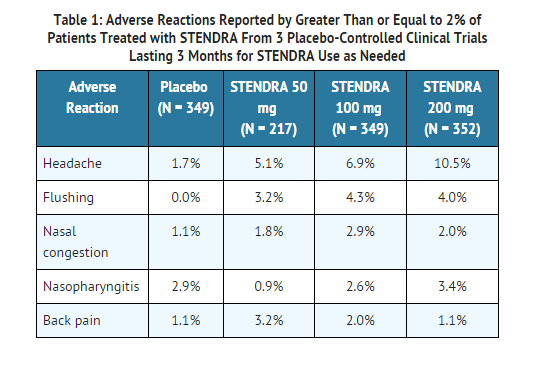
- Adverse reactions reported by greater than or equal to 1%, but less than 2% of patients in any avanafil dose group, and greater than placebo included: upper respiratory infection (URI), bronchitis, influenza, sinusitis, sinus congestion, hypertension, dyspepsia, nausea, constipation, and rash.
- In an open-label, long-term extension study of two of these randomized, double-blind, placebo-controlled trials, the total duration of treatment was up to 52 weeks. Among the 712 patients who participated in this open-label extension study, the mean age of the population was 56.4 years (range from 23 to 88 years). The discontinuation rate due to adverse reactions for patients treated with avanafil (50 mg, 100 mg, or 200 mg) was 2.8%.
- In this extension trial, all eligible patients were initially assigned to avanafil 100 mg. At any point during the trial, patients could request to have their dose of avanafil increased to 200 mg or decreased to 50 mg based on their individual response to treatment. In total, 536 (approximately 75%) patients increased their dose to 200 mg and 5 (less than 1%) patients reduced their dose to 50 mg.
- Table 2 presents the adverse reactions reported when avanafil was taken as recommended (on an as-needed basis) in this open-label extension trial.
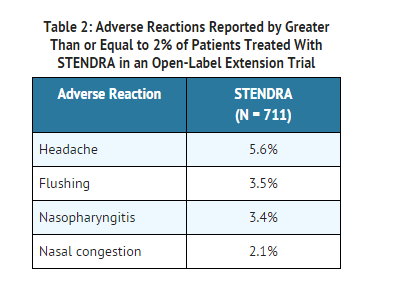
- Adverse reactions reported by greater than or equal to 1%, but less than 2% of patients in the open-label extension study included: upper respiratory infection (URI), influenza, sinusitis, bronchitis, dizziness, back pain, arthralgia, hypertension, and diarrhea.
- The following events occurred in less than 1% of patients in the three placebo-controlled 3-month clinical trials and/or the open-label, long-term extension study lasting 12 months. A causal relationship to avanafil is uncertain. Excluded from this list are those events that were minor, those with no plausible relation to drug use, and reports too imprecise to be meaningful.
- Body as a whole — edema peripheral, fatigue
- Cardiovascular — angina, unstable angina, deep vein thrombosis, palpitations
- Digestive — gastritis, gastroesophageal reflux disease, hypoglycemia, blood glucose increased, alanine aminotransferase increased, oropharyngeal pain, stomach discomfort, vomiting
- Musculoskeletal — muscle spasms, musculoskeletal pain, myalgia, pain in extremity
- Nervous — depression, insomnia, somnolence, vertigo
- Skin and Appendages – pruritus
- Urogenital – balanitis, erection increased, hematuria, nephrolithiasis, pollakiuria, urinary tract infection
- In an additional randomized, double-blind, placebo-controlled study lasting up to 3 months in 298 men who had undergone bilateral nerve-sparing radical prostatectomy for prostate cancer, the mean age of patients was 58.4 years (range 40 – 70). Table 3 presents the adverse reactions reported in this study.
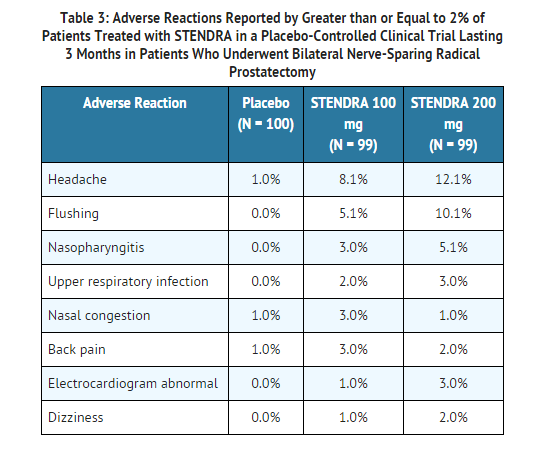
- A randomized, double-blind, placebo-controlled 2 months study was conducted in 435 subjects with a mean age of 58.2 years (range 24 to 86 years) to determine the time to onset of effect of avanafil, defined as the time to the first occurrence of an erection sufficient for sexual intercourse. Table 4 presents the adverse reactions occurring in ≥ 2% of subjects treated with avanafil.
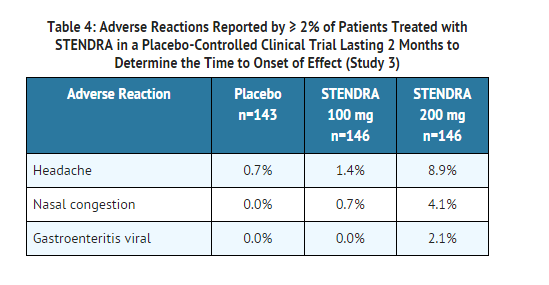
- Across all trials with any avanafil dose, 1 subject reported a change in color vision.
Postmarketing Experience
Ophthalmologic:
- Non-arteritic anterior ischemic optic neuropathy (NAION), a cause of decreased vision including permanent loss of vision, has been reported rarely post-marketing in temporal association with the use of phosphodiesterase type 5 (PDE5) inhibitors. Most, but not all, of these patients had underlying anatomic or vascular risk factors for developing NAION, including but not necessarily limited to: low cup to disc ratio ("crowded disc"), age over 50, diabetes, hypertension, coronary artery disease, hyperlipidemia, and smoking. It is not possible to determine whether these events are related directly to the use of PDE5 inhibitors, to the patient's underlying vascular risk factors or anatomical defects, to a combination of these factors, or to other factors.
Drug Interactions
Potential for Pharmacodynamic Interactions with avanafil
Nitrates
- Administration of STENDRA to patients who are using any form of organic nitrate is contraindicated. In a clinical pharmacology trial, avanafil was shown to potentiate the hypotensive effect of nitrates. In a patient who has taken avanafil, where nitrate administration is deemed medically necessary in a life-threatening situation, at least 12 hours should elapse after the last dose of avanafil before nitrate administration is considered. In such circumstances, nitrates should only be administered under close medical supervision with appropriate hemodynamic monitoring.
Alpha-Blockers
- Caution is advised when PDE5 inhibitors are co-administered with alpha-blockers. PDE5 inhibitors, including avanafil, and alpha-adrenergic blocking agents are both vasodilators with blood pressure-lowering effects. When vasodilators are used in combination, an additive effect on blood pressure may be anticipated. In some patients, concomitant use of these two drug classes can lower blood pressure significantly leading to symptomatic hypotension (e.g., dizziness, lightheadedness, fainting).
Antihypertensives
- PDE5 inhibitors, including avanafil, are mild systemic vasodilators. A clinical pharmacology trial was conducted to assess the effect of avanafil on the potentiation of the blood pressure-lowering effects of selected antihypertensive medications (amlodipine and enalapril). Additional reductions in blood pressure of 3 to 5 mmHg occurred following co-administration of a single 200 mg dose of avanafil with these agents compared with placebo.
Alcohol
- Both alcohol and PDE5 inhibitors, including avanafil, act as vasodilators. When vasodilators are taken in combination, blood pressure-lowering effects of each individual compound may be increased. Substantial consumption of alcohol (e.g., greater than 3 units) in combination with avanafil can increase the potential for orthostatic signs and symptoms, including increase in heart rate, decrease in standing blood pressure, dizziness, and headache.
Potential for Other Drugs to Affect Avanafil
- Avanafil is a substrate of and predominantly metabolized by CYP3A4. Studies have shown that drugs that inhibit CYP3A4 can increase avanafil exposure.
Strong CYP3A4 Inhibitors
- Ketoconazole (400 mg daily), a selective and strong inhibitor of CYP3A4, increased avanafil 50 mg single-dose systemic exposure (AUC) and maximum concentration (Cmax) equal to 13-fold and 3-fold, respectively, and prolonged the half-life of avanafil to approximately 9 hours. Other potent inhibitors of CYP3A4 (e.g., itraconazole, clarithromycin, nefazadone, ritonavir, saquinavir, nelfinavir, indinavir, atanazavir, and telithromycin) would be expected to have similar effects. Do not use avanafil in patients taking strong CYP3A4 inhibitors .
- HIV Protease inhibitor — Ritonavir (600 mg twice daily), a strong CYP3A4 inhibitor, which also inhibits CYP2C9, increased avanafil 50 mg single-dose Cmax and AUC equal to approximately 2-fold and 13-fold, and prolonged the half-life of avanafil to approximately 9 hours in healthy volunteers. Do not use avanafil in patients taking ritonavir.
Moderate CYP3A4 Inhibitors
- Erythromycin (500 mg twice daily) increased avanafil 200 mg single-dose Cmax and AUC equal to approximately 2-fold and 3-fold, respectively, and prolonged the half-life of avanafil to approximately 8 hours in healthy volunteers. Moderate CYP3A4 inhibitors (e.g., erythromycin, amprenavir, aprepitant, diltiazem, fluconazole, fosamprenavir, and verapamil) would be expected to have similar effects. Consequently, the maximum recommended dose of avanafil is 50 mg, not to exceed once every 24 hours for patients taking concomitant moderate CYP3A4 inhibitors.
- Although specific interactions have not been studied, other CYP3A4 inhibitors, including grapefruit juice are likely to increase avanafil exposure.
Weak CYP3A4 Inhibitors
- No in vivo drug-drug interaction studies with weak CYP3A4 inhibitors were conducted.
CYP3A4 Substrate
- When administered with avanafil 200 mg, amlodipine (5 mg daily) increased the Cmax and AUC of avanafil by approximately 22% and 70%, respectively. The half-life of avanafil was prolonged to approximately 10 hrs. The Cmax and AUC of amlodipine decreased by approximately 9% and 4%, respectively.
Cytochrome P450 Inducers
- The potential effect of CYP inducers on the pharmacokinetics of avanafil was not evaluated. The concomitant use of avanafil and CYP inducers is not recommended.
Potential for Avanafil to Affect Other Drugs
In vitro studies
- Avanafil had no effect on CYP1A1/2, 2A6, 2B6, and 2E1 (IC50 greater than 100 micromolar) and weak inhibitory effects toward other isoforms (CYP2C8, 2C9, 2C19, 2D6, 3A4). Major circulating metabolites of avanafil (M4 and M16) had no effect on CYPs 1A, 2A6, 2B6, 2C8, 2C9, 2C19, 2D6, 2E1, and 3A4. Avanafil and its metabolites (M4 and M16) are unlikely to cause clinically significant inhibition of CYPs 1A, 2A6, 2B6, 2C8, 2C9, 2C19, 2D6, 2E1, or 3A4.
In vivo studies
- Warfarin —A single 200 mg dose of avanafil did not alter the changes in PT or INR induced by warfarin, and did not affect collagen-induced platelet aggregation or the AUC or Cmax of R- or S-warfarin, a 2C9 substrate.
- Desipramine — A single avanafil 200 mg dose increased AUC and Cmax of a single 50 mg dose of desipramine, a CYP2D6 substrate, by 5.7% and 5.2%, respectively.
- Omeprazole — A single avanafil 200 mg dose increased AUC and Cmax of a single 40 mg dose of omeprazole, a CYP2C19 substrate, given once daily for 8 days by 5.9% and 8.6%, respectively.
- Rosiglitazone — A single avanafil 200 mg dose increased AUC by 2.0% and decreased Cmax by 14% of a single 8 mg dose of rosiglitazone, a CYP2C8 substrate.
- Amlodipine — A single avanafil 200 mg dose did not affect the pharmacokinetics of amlodipine (5 mg daily), a CYP3A4 substrate [see DOSAGE AND ADMINISTRATION (2.3)].
- Alcohol — A single oral dose of avanafil 200 mg did not affect alcohol (0.5 g ethanol/kg) plasma concentrations
Use in Specific Populations
Pregnancy
Pregnancy Category (FDA): Pregnancy Category C
- Avanafil is not indicated for use in women. There are no adequate and well-controlled studies of avanafil in pregnant women.
- Australian Drug Evaluation Committee (ADEC) Pregnancy Category
There is no Australian Drug Evaluation Committee (ADEC) guidance on usage of Avanafil in women who are pregnant.
Labor and Delivery
There is no FDA guidance on use of Avanafil during labor and delivery.
Nursing Mothers
There is no FDA guidance on the use of Avanafil with respect to nursing mothers.
Pediatric Use
- Avanafil is not indicated for use in pediatric patients. Safety and efficacy in patients below the age of 18 years has not been established.
Geriatic Use
- Of the total number of subjects in clinical studies of avanafil, approximately 23% were 65 and over. No overall differences in efficacy and safety were observed between subjects over 65 years of age compared to younger subjects; therefore no dose adjustment is warranted based on age alone. However, a greater sensitivity to medication in some older individuals should be considered.
Gender
There is no FDA guidance on the use of Avanafil with respect to specific gender populations.
Race
There is no FDA guidance on the use of Avanafil with respect to specific racial populations.
Renal Impairment
- In a clinical pharmacology trial using single 200 mg doses of avanafil, avanafil exposure (AUC or Cmax) in normal subjects was comparable to patients with mild (creatinine clearance greater than or equal to 60 to less than 90 mL/min) or moderate (creatinine clearance greater than or equal to 30 to less than 60 mL/min) renal impairment. No dose adjustment is necessary for patients with mild to moderate renal impairment (creatinine clearance greater than or equal to 30 to less than 90 mL/min). The pharmacokinetics of avanafil in patients with severe renal disease or on renal dialysis has not been studied; do not use avanafil in such patients.
Hepatic Impairment
- In a clinical pharmacology trial, avanafil AUC and Cmax in patients with mild hepatic impairment (Child-Pugh Class A) was comparable to that in healthy subjects when a dose of 200 mg was administered. Avanafil Cmax was approximately 51% lower and AUC was 11% higher in patients with moderate hepatic impairment (Child Pugh Class B) compared to subjects with normal hepatic function. No dose adjustment is necessary for patients with mild to moderate hepatic impairment (Child Pugh Class A or B). The pharmacokinetics of avanafil in patients with severe hepatic disease has not been studied; do not use avanafil in such patients.
Females of Reproductive Potential and Males
There is no FDA guidance on the use of Avanafil in women of reproductive potentials and males.
Immunocompromised Patients
There is no FDA guidance one the use of Avanafil in patients who are immunocompromised.
Administration and Monitoring
Administration
- Oral
Monitoring
There is limited information regarding Monitoring of Avanafil in the drug label.
IV Compatibility
There is limited information regarding IV Compatibility of Avanafil in the drug label.
Overdosage
- Single doses up to 800 mg have been given to healthy subjects, and multiple doses up to 300 mg have been given to patients. In cases of overdose, standard supportive measures should be adopted as required. Renal dialysis is not expected to accelerate clearance because avanafil is highly bound to plasma proteins and is not significantly eliminated in the urine.
Pharmacology

| |
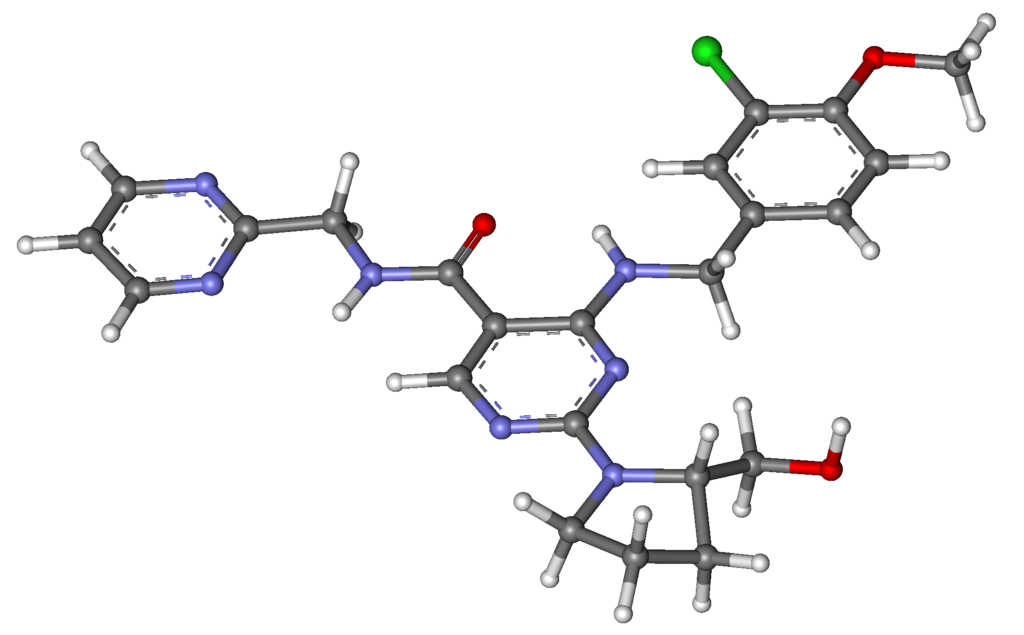
| |
Avanafil
| |
| Systematic (IUPAC) name | |
| (S)-4-((3-chloro-4-methoxybenzyl)amino)-2-(2-(hydroxymethyl)pyrrolidin-1-yl)-N-(pyrimidin-2-ylmethyl)pyrimidine-5-carboxamide | |
| Identifiers | |
| CAS number | |
| ATC code | G04 |
| PubChem | |
| Chemical data | |
| Formula | Template:OrganicBox atomTemplate:OrganicBox atomTemplate:OrganicBoxTemplate:OrganicBoxTemplate:OrganicBoxTemplate:OrganicBoxTemplate:OrganicBox atomTemplate:OrganicBoxTemplate:OrganicBoxTemplate:OrganicBoxTemplate:OrganicBoxTemplate:OrganicBoxTemplate:OrganicBoxTemplate:OrganicBox atomTemplate:OrganicBoxTemplate:OrganicBox atomTemplate:OrganicBoxTemplate:OrganicBoxTemplate:OrganicBoxTemplate:OrganicBoxTemplate:OrganicBoxTemplate:OrganicBoxTemplate:OrganicBox |
| Mol. mass | 483.951 g/mol |
| SMILES | & |
| Pharmacokinetic data | |
| Bioavailability | ? |
| Metabolism | ? |
| Half life | ? |
| Excretion | ? |
| Therapeutic considerations | |
| Licence data |
|
| Pregnancy cat. |
C(US) |
| Legal status |
[[Prescription drug|Template:Unicode-only]](US) |
| Routes | Oral |
Mechanism of Action
- The physiologic mechanism of erection of the penis involves release of nitric oxide (NO) in the corpus cavernosum during sexual stimulation. NO then activates the enzyme guanylate cyclase, which results in increased levels of cGMP, producing smooth muscle relaxation in the corpus cavernosum and allowing inflow of blood. Avanafil has no direct relaxant effect on isolated human corpus cavernosum, but enhances the effect of NO by inhibiting PDE5, which is responsible for degradation of cGMP in the corpus cavernosum. Because sexual stimulation is required to initiate the local release of NO, the inhibition of PDE5 has no effect in the absence of sexual stimulation.
- Studies in vitro have shown that avanafil is selective for PDE5. Its effect is more potent on PDE5 than on other known phosphodiesterases (greater than 100-fold for PDE6; greater than 1,000-fold for PDE4, PDE8, and PDE10; greater than 5,000-fold for PDE2 and PDE7; greater than 10,000-fold for PDE1, PDE3, PDE9, and PDE11). Avanafil is greater than 100-fold more potent for PDE5 than PDE6, which is found in the retina and is responsible for phototransduction. In addition to human corpus cavernosum smooth muscle, PDE5 is also found in other tissues including platelets, vascular and visceral smooth muscle, and skeletal muscle, brain, heart, liver, kidney, lung, pancreas, prostate, bladder, testis, and seminal vesicle. The inhibition of PDE5 in some of these tissues by avanafil may be the basis for the enhanced platelet anti-aggregatory activity of NO observed in vitro and peripheral vasodilatation in vivo.
Structure
- STENDRA (avanafil) is a selective inhibitor of cGMP-specific PDE5.
- Avanafil is designated chemically as (S)-4-[(3-Chloro-4-methoxybenzyl)amino]-2-[2-(hydroxymethyl)-1-pyrrolidinyl]-N-(2-pyrimidinylmethyl)-5-pyrimidinecarboxamide and has the following structural formula:
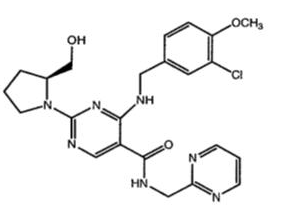
- Avanafil occurs as white crystalline powder, molecular formula C23H26ClN7O3 and molecular weight of 483.95 and is slightly soluble in ethanol, practically insoluble in water, and soluble in 0.1 mol/L hydrochloric acid. Avanafil, for oral administration, is supplied as oval, pale yellow tablets containing 50 mg, 100 mg, or 200 mg avanafil debossed with dosage strengths. In addition to the active ingredient, avanafil, each tablet contains the following inactive ingredients: mannitol, fumaric acid, hydroxypropylcellulose, low substituted hydroxypropylcellulose, calcium carbonate, magnesium stearate, and ferric oxide yellow.
Pharmacodynamics
Effects of Avanafil on Erectile Response
- In a single-blind, placebo-controlled, single-dose trial of 82 patients with either organic and/or psychogenic ED, visual sexual stimulation resulted in improved erections after avanafil administration compared to placebo, as assessed by an objective measurement of hardness and duration of erections (RigiScan®). Efficacy was assessed by RigiScan at discrete time intervals ranging from 20 – 40 minutes after dosing to 100 – 120 minutes after dosing.
Effects of Avanafil on Blood Pressure
- Single oral doses of avanafil (200 mg) administered to healthy male volunteers resulted in mean changes from baseline in systolic/diastolic blood pressure of -5.3/-3.7 mmHg at 1 hour after dosing, compared to mean changes from baseline in the placebo group of 2.7/-0.4 mmHg. The reductions in systolic/diastolic blood pressure at 1 hour after dosing of avanafil 200 mg compared to placebo were 8.0/3.3 mmHg.
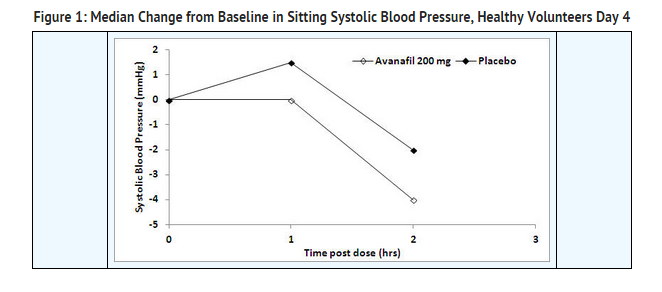
Effects on Cardiac Electrophysiology
- The effect of single 100 or 800 mg doses of avanafil on the QT interval were evaluated in a randomized, double-blind, placebo, and active (moxifloxacin) –controlled crossover study in 52 healthy male subjects aged 18 to 45 years. There were no significant effects of the 100 mg dose. The mean QTc (Fridericia QT correction) for avanafil 800 mg relative to placebo was 9.4 milliseconds (two-sided 90% CI=7.2, 11.6). An 800 mg dose of avanafil (4 times the highest recommended dose) was chosen because this dose yields exposures greater than those observed upon co-administration of avanafil with strong CYP3A4 inhibitors. A double-blind, randomized, placebo- and active-controlled (moxifloxacin), thorough QT/QTc trial of avanafil (100 and 800 mg) in healthy male subjects demonstrated that avanafil did not cause any significant changes in QTc interval or ventricular repolarization.
Effects of Avanafil on Blood Pressure When Administered with Nitrates
- In a clinical pharmacology trial, a single dose of avanafil 200 mg was shown to potentiate the hypotensive effect of nitrates. The use of avanafil in patients taking any form of nitrates is contraindicated.
- A trial was conducted to assess the degree of interaction between nitroglycerin and avanafil, should nitroglycerin be required in an emergency situation after avanafil was taken. This was a single-center, double-blind, randomized, 3-way crossover trial of healthy males from 30 to 60 years of age. Subjects were divided among 5 trial groups with the trial group being determined by the time interval between treatment with trial drug and glyceryl trinitrate administration. Subjects were assigned to trial groups sequentially and hemodynamic results from the previous group were reviewed for serious adverse events (SAEs) before the next group received treatment. Each subject was dosed with all 3 study drugs (avanafil 200 mg, sildenafil citrate 100 mg, and placebo) in random order. Subjects were administered a single dose of 0.4 mg sublingual nitroglycerin (NTG) at pre-specified time points, following their dose of trial drug (0.5, 1, 4, 8, or 12 hours). Overall, 14 (15%) subjects treated with placebo and 28 (28%) subjects treated with avanafil, had clinically significant decreases in standing SBP, defined as greater than or equal to 30 mmHg decrease in SBP, after glyceryl trinitrate administration. Mean maximum decreases are shown in Table 5.
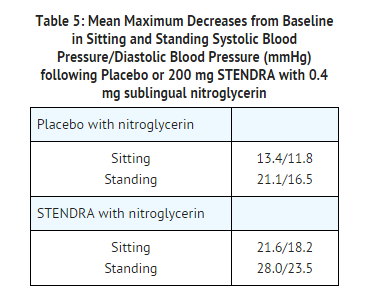
- Like other PDE5 inhibitors, avanafil administration with nitrates is contraindicated. In a patient who has taken avanafil, where nitrate administration is deemed medically necessary in a life threatening situation, at least 12 hours should elapse after the last dose of avanafil before nitrate administration is considered. In such circumstances, nitrates should still only be administered under close medical supervision with appropriate hemodynamic monitoring.
Effects of Avanafil on Blood Pressure When Administered with Alpha-Blockers
- A single-center, randomized, double-blinded, placebo-controlled, two-period crossover trial was conducted to investigate the potential interaction of avanafil with alpha-blocker agents in healthy male subjects which consisted of two cohorts:
- Cohort A (N=24): Subjects received oral doses of doxazosin once daily in the morning at 1 mg for 1 day (Day 1), 2 mg for 2 days (Days 2 – 3), 4 mg for 4 days (Days 4 – 7), and 8 mg for 11 days (Days 8 – 18). On Days 15 and 18, the subjects also received a single oral dose of either 200 mg avanafil or placebo, according to the treatment randomization code. The avanafil or placebo doses were administered 1.3 hours after the doxazosin administration on Days 15 and 18. The co-administration was designed so that doxazosin (Tmax ~2 hours) and avanafil (Tmax ~0.7 hours) would reach their peak plasma concentrations at the same time.
- Cohort B (N=24): Subjects received 0.4 mg daily oral doses of tamsulosin in the morning for 11 consecutive days (Days 1 – 11). On Days 8 and 11, the subjects also received a single oral dose of either 200 mg avanafil or placebo, according to the treatment randomization code. The avanafil or placebo doses were administered 3.3 hours after the tamsulosin administration on Days 8 and 11. The co-administration was designed so that tamsulosin (Tmax ~4 hours) and avanafil (Tmax ~0.7 hours) would reach their peak plasma concentrations at the same time.
- Supine and sitting BP and pulse rate measurements were recorded before and after avanafil or placebo dosing.
- A total of seven subjects in Cohort A (doxazosin) experienced potentially clinically important absolute values or changes from baseline in standing SBP or DBP. Three subjects experienced standing SBP values less than 85 mmHg. One subject experienced a decrease from baseline in standing SBP greater than 30 mmHg following avanafil. Two subjects experienced standing DBP values less than 45 mmHg following avanafil. Four subjects experienced decreases from baseline in standing DBP greater than 20 mmHg following avanafil. One subject experienced such decreases following placebo. There were no severe adverse events related to hypotension reported during the trial. There were no cases of syncope.
- A total of five subjects in Cohort B (tamsulosin) experienced potentially clinically important absolute values or changes from baseline in standing SBP or DBP. Two subjects experienced standing SBP values less than 85 mmHg following avanafil. One subject experienced a decrease from baseline in standing SBP greater than 30 mmHg following avanafil. Two subjects experienced standing DBP values less than 45 mmHg following avanafil. Four subjects experienced decreases from baseline in standing DBP greater than 20 mmHg following avanafil; one subject experienced such decreases following placebo. There were no severe adverse events related to hypotension reported during the trial. There were no cases of syncope.
- Table 6 presents the placebo-subtracted mean maximum decreases from baseline (95% CI) in systolic blood pressure results for the 24 subjects who received avanafil 200 mg and matching placebo.
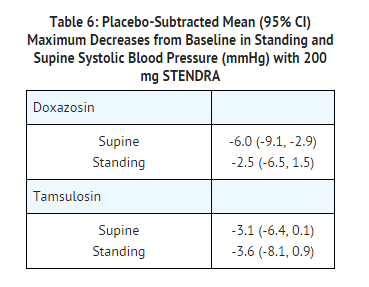
Blood pressure effects (standing SBP) in normotensive men on stable dose doxazosin (8 mg) following administration of avanafil 200 mg or placebo, are shown in Figure 2. Blood pressure effects (standing SBP) in normotensive men on stable dose tamsulosin (0.4 mg) following administration of avanafil 200 mg or placebo are shown in Figure 3.
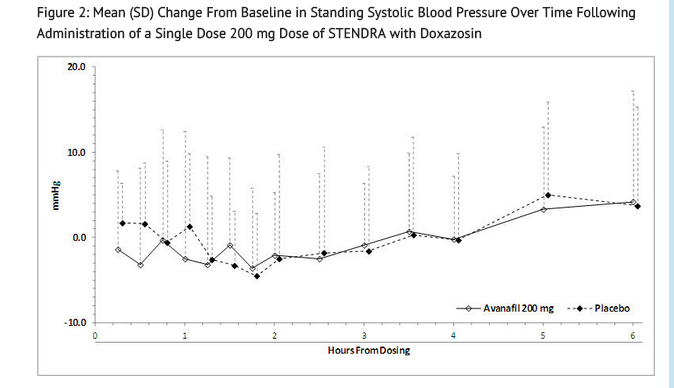
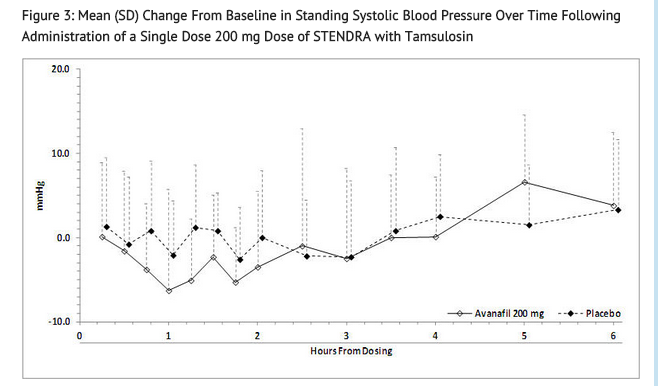
Effects of Avanafil on Blood Pressure When Administered with Enalapril
- A trial was conducted to assess the interaction of enalapril (20 mg daily) and avanafil 200 mg. Single doses of 200 mg avanafil co-administered with enalapril caused a mean maximum decrease in supine systolic/diastolic blood pressure of 1.8/3.5 mmHg (compared to placebo), accompanied by a mean maximum increase in pulse rate of 1.0 bpm.
Effects of Avanafil on Blood Pressure When Administered with Amlodipine
- A trial was conducted to assess the interaction of amlodipine (5 mg daily) and avanafil 200 mg. Single doses of 200 mg avanafil co-administered with amlodipine caused a mean maximum decrease in supine systolic blood pressure of 1.2 mmHg (compared to placebo), accompanied by a mean maximum increase in pulse rate of 1.0 bpm; the mean maximum decrease in diastolic blood pressure was less than that observed in the placebo group. There was no effect of avanafil on amlodipine plasma concentrations. Concomitant amlodipine was associated with 22% and 70% increases in avanafil Cmax and AUC, respectively.
Effects of Avanafil on Blood Pressure When Administered with Alcohol
- Alcohol and PDE5 inhibitors, including avanafil, are mild systemic vasodilators. The interaction of avanafil with alcohol was evaluated in a clinical pharmacology trial. Alcohol was administered at a dose of 0.5 g/kg, which is equivalent to approximately 3 ounces of 80-proof vodka in a 70-kg male, and avanafil was administered at a dose of 200 mg. All patients consumed the entire alcohol dose within 15 minutes of starting. Blood alcohol levels of 0.057% were confirmed. There were no reports of orthostatic hypotension or dizziness. Additional maximum supine systolic/diastolic blood pressure decreases of 3.5/4.5 mm Hg and additional maximum pulse rate increase of 9.3 bpm were observed when avanafil was taken with alcohol compared to alcohol alone. Avanafil did not affect alcohol plasma concentrations.
Effects of Avanafil on Semen
- A single 200 mg dose of avanafil had no acute effect on sperm motility or sperm morphology in a group of healthy male subjects. The effect of avanafil on human spermatogenesis is unknown.
Effects of Avanafil on Vision
- Single oral doses of Type 5 phosphodiesterase inhibitors have demonstrated transient dose-related impairment of color discrimination (blue/green), using the Farnsworth-Munsell 100-hue test, with peak effects near the time of peak plasma levels. This finding is consistent with the inhibition of PDE6, which is involved in phototransduction in the retina.
Pharmacokinetics
- Mean avanafil plasma concentrations measured after the administration of a single oral dose of 50 or 200 mg to healthy male volunteers are depicted in Figure 4. The pharmacokinetics of avanafil are dose proportional from 12.5 to 600 mg.
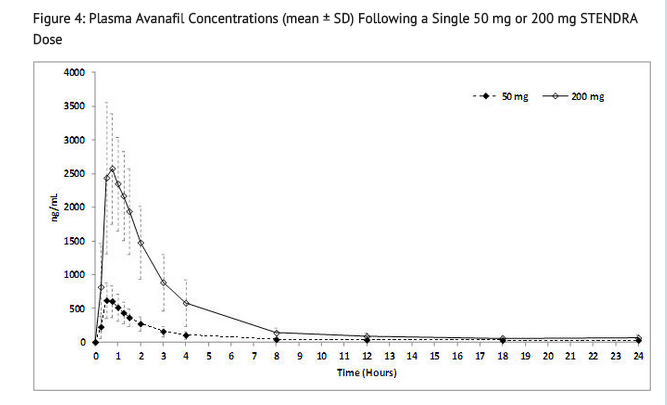
Absorption and Distribution
- STENDRA is rapidly absorbed after oral administration, with a median Tmax of 30 to 45 minutes in the fasted state. When STENDRA (200 mg) is taken with a high fat meal, the rate of absorption is reduced, with a mean delay in Tmax of 1.12 to 1.25 hours and a mean reduction in Cmax of 39% (200 mg). There was an approximate 3.8% decrease in AUC. The small changes in avanafil Cmax and AUC are considered of minimal clinical significance; therefore, STENDRA may be administered with or without food. The mean accumulation ratio is approximately 1.2. Avanafil is approximately 99% bound to plasma proteins. Protein binding is independent of total drug concentrations, age, renal and hepatic function.
- Based upon measurements of avanafil in semen of healthy volunteers 45-90 minutes after dosing, less than 0.0002% of the administered dose appeared in the semen of patients.
Metabolism and Excretion
- Avanafil is cleared predominantly by hepatic metabolism, mainly by the CYP3A4 enzyme and to a minor extent by CYP2C isoform. The plasma concentrations of the major circulating metabolites, M4 and M16, are approximately 23% and 29% that of the parent compound, respectively. The M4 metabolite has an in vitro inhibitory potency for PDE5, 18% of that of avanafil, and M4 accounts for approximately 4% of the pharmacologic activity of avanafil. The M16 metabolite was inactive against PDE5.
- Avanafil was extensively metabolized in humans. After oral administration, avanafil is excreted as metabolites predominantly in the feces (approximately 62% of administered oral dose) and to a lesser extent in the urine (approximately 21% of the administered oral dose). Avanafil has a terminal elimination half-life of approximately 5 hours.
Geriatric
- The pharmacokinetics of a single 200 mg avanafil administered to fourteen healthy elderly male volunteers (65-80 years) and eighteen healthy younger male volunteers (18-43 years of age) were compared. AUC0-inf increased by 6.8% and Cmax decreased by 2.1% in the elderly group, compared to the younger group. However, greater sensitivity to medications in some older individuals should be considered.
Renal Impairment
- The pharmacokinetics of a single 200 mg avanafil administered to nine patients with mild (creatinine clearance greater than or equal to 60 and less than 90 mL/min) and to ten patients with moderate (creatinine clearance greater than or equal to 30 to less than 60 mL/min) renal impairment were evaluated. AUC0-inf decreased by 2.9% and Cmax increased by 2.8% in patients with mild renal impairment, compared to healthy volunteers with normal renal function. AUC0-inf increased by 9.1% and Cmax decreased by 2.8% in patients with moderate renal impairment, compared to healthy volunteers with normal renal function. There is no data available for subjects with severe renal insufficiency or end-stage renal disease on hemodialysis.
Hepatic Impairment
- The pharmacokinetics of a single 200 mg avanafil administered to eight patients with mild hepatic impairment (Child-Pugh A) and eight patients with moderate hepatic impairment (Child-Pugh B) were evaluated. AUC0-inf increased by 3.8% and Cmax decreased by 2.7% in patients with mild hepatic impairment, compared to healthy volunteers with normal hepatic function. AUC0-inf increased by 11.2% and Cmax decreased by 51% in patients with moderate hepatic impairment, compared to healthy volunteers with normal hepatic function. There is no data available for subjects with severe hepatic impairment (Child-Pugh Class C).
Drug Interactions
- Effect of CYP3A4 Inhibitors on Avanafil: Strong and moderate CYP3A4 inhibitors increase plasma concentrations of avanafil. The effect of strong CYP3A4 inhibitors, ketoconazole and ritonavir, and moderate CYP3A4 inhibitor, erythromycin, on avanafil pharmacokinetics was studied in an open-label, randomized, one-sequence crossover, three-way parallel study.
Strong CYP3A4 Inhibitors
- Fifteen healthy male volunteers received 400 mg ketoconazole (2 tablets containing 200 mg ketoconazole) once daily for 5 days (Days 2-6) and a single 50 mg avanafil on Days 1 and 6. Twenty-four hour pharmacokinetics of avanafil on Days 1 and 6 were compared. Co-administration with the strong CYP3A4 inhibitor ketoconazole resulted in an approximate 13-fold increase in AUC0-inf and 3.1-fold increase in Cmax. Fourteen healthy male volunteers received 300 mg ritonavir (3 tablets containing 100 mg ritonavir) twice daily for 1 day (Day 2), 400 mg twice daily for 1 day (Day 3), 600 mg twice daily for 5 days (Days 4-8), and a single 50 mg avanafil on Days 1 and 8. Twenty-four hour pharmacokinetics of avanafil on Days 1 and 8 were compared. Co-administration with the strong CYP3A4 inhibitor ritonavir resulted in an approximate 13-fold increase in AUC0-inf and 2.4-fold increase in Cmax of avanafil
Moderate CYP3A4 Inhibitors
- Fifteen healthy male volunteers received 500 mg erythromycin (2 tablets containing 250 mg erythromycin) every 12 hrs for 5 days (Days 2-6) and a single 200 mg avanafil (2 tablets containing 100 mg avanafil) on Days 1 and 6. Twenty-four hour pharmacokinetics of avanafil on Days 1 and 6 were compared. Co-administration with the moderate CYP3A4 inhibitor erythromycin resulted in an approximate 3.6-fold increase in AUC0-inf and 2.0-fold increase in Cmax of avanafil.
Effect of Avanafil on Other Drugs:
Warfarin
- The effect of avanafil on warfarin pharmacokinetics and pharmacodynamics was evaluated in a double-blind, randomized, placebo-controlled, two-way crossover study. Twenty-four healthy male volunteers were randomized to receive either 200 mg avanafil or matching placebo for 9 days. On Day 3 of each period, volunteers received a single 25 mg warfarin. Pharmacokinetics of R- and S-warfarin, PT, and INR prior to warfarin dosing and up to 168 hrs after warfarin administration were compared. Platelet aggregation prior to warfarin dosing and up to 24 hrs after warfarin administration were compared. PT, INR, and platelet aggregation did not change with avanafil administration: 23.1 sec, 2.2, and 75.5%, respectively. Co-administration with avanafil resulted in an approximate 1.6% increase in AUC0-inf and 5.2% decrease in Cmax of S-warfarin.
Omeprazole, Rosiglitazone, and Desipramine
- The effect of avanafil on the pharmacokinetics of omeprazole (a CYP2C19 substrate), rosiglitazone (a CYP2C8 substrate), and desipramine (a CYP2D6 substrate) was evaluated in an open-label, three cohort, crossover study. Nineteen healthy male volunteers received a single 40 omeprazole delayed-release capsule once daily for 8 days (Days 1-8), and a single 200 mg avanafil on Day 8. Twelve hour pharmacokinetics of omeprazole on Days 7 and 8 were compared. Co-administration with avanafil resulted in an approximate 5.9% increase in AUC0-inf and 8.6% increase in Cmax of omeprazole. Twenty healthy male volunteers received a single 8 mg rosiglitazone tablet then a single 200 mg avanafil. Twenty-four hour pharmacokinetics of rosiglitazone with and without avanafil were compared. Co-administration with avanafil resulted in an approximate 2.0% increase in AUC0-inf and 14% decrease in Cmax of rosiglitazone. Twenty healthy male volunteers received a single 50 mg desipramine tablet then a single 200 mg avanafil tablet 2 hours after desipramine. Ninety-six hour pharmacokinetics of desipramine with and without avanafil were compared. Co-administration with avanafil resulted in an approximate 5.7% increase in AUC0-inf and 5.2% increase in Cmax of desipramine.
Nonclinical Toxicology
Carcinogenesis, Mutagenesis and Impairment of Fertility
Carcinogenesis
- Avanafil was not carcinogenic to CD-1 mice when administered daily at doses of 100, 200, or 600 mg/kg/day orally by gavage for at least 98 weeks (approximately 11 times the MRHD on an AUC basis) or to Sprague Dawley rats when administered daily at doses of 100, 300, or 1000 mg/kg/day orally by gavage for at least 100 weeks (approximately 8 times for males and 34 times for females above the MRHD on an AUC basis).
Mutagenesis
- Avanafil was not genotoxic in a series of tests. Avanafil was not mutagenic in Ames assays. Avanafil was not clastogenic in chromosome aberration assays using Chinese hamster ovary and lung cells, or in vivo in the mouse micronucleus assay. Avanafil did not affect DNA repair when tested in the rat unscheduled DNA synthesis assay.
Impairment of Fertility
- In a rat fertility and early embryonic development study administered 100, 300, or 1000 mg/kg/day for 28 days prior to paring and continued until euthanasia for males, and 14 days prior to pairing to gestation day 7 for females, a decrease in fertility, no or reduced sperm motility, altered estrous cycles, and an increased percentage of abnormal sperm (broken sperm with detached heads) occurred at exposures in males approximately 11 times the human exposure at a dose of 200 mg. The altered sperm effects were reversible at the end of a 9-week drug-free period. Systemic exposure at the NOAEL (300 mg/kg/day) was comparable to the human AUC at the MRHD of 200 mg.
Clinical Studies
- Avanafil was evaluated in three randomized, double-blind, placebo-controlled, parallel group trials of 2 to 3 months in duration. avanafil was taken as needed at doses of 50 mg, 100 mg, and 200 mg (Study 1) and 100 mg and 200 mg (Study 2 and Study 3). Patients were instructed to take 1 dose of study drug approximately 30 minutes (Study 1 and Study 2) or approximately 15 minutes (Study 3) prior to initiation of sexual activity. Food and alcohol intake was not restricted.
- A subset of patients from 2 of these trials were enrolled into an open-label extension trial. In the open-label extension trial, all eligible patients were initially assigned to avanafil 100 mg. At any point during the trial, patients could request to have their dose of avanafil increased to 200 mg or decreased to 50 mg based on their individual response to treatment.
- The 3 primary outcome measures in Studies 1 and 2 were the erectile function domain of the International Index of Erectile Function (IIEF) and Questions 2 and 3 from Sexual Encounter Profile (SEP). The IIEF is a 4-week recall questionnaire that was administered at baseline and at 4-week intervals during treatment. The IIEF erectile function domain has a 30-point total score, where the higher scores reflect better erectile function. The SEP included diary-based measures of erectile function. Patients recorded information regarding each sexual attempt made throughout the trial. Question 2 of the SEP asks "Were you able to insert your penis into your partner's vagina?" Question 3 of the SEP asks "Did your erection last long enough for you to have successful intercourse?"
- In Study 3, the primary efficacy variable was the per-subject proportion of sexual attempts that had an erectogenic effect within approximately 15 minutes following dosing, where an erectogenic effect was defined as an erection sufficient for vaginal penetration and that enabled satisfactory completion of sexual intercourse.
Results in the General ED Population (Study 1):
- Avanafil was evaluated in 646 men with ED of various etiologies (organic, psychogenic, mixed) in a randomized, double-blind, parallel, placebo-controlled fixed dose trial of 3 months in duration. The mean age was 55.7 years (range 23 to 88 years). The population was 85.6% White, 13.2% Black, 0.9% Asian, and 0.3% of other races. The mean duration of ED was approximately 6.5 years. Avanafil at doses of 50 mg, 100 mg, and 200 mg demonstrated statistically significant improvement in all 3 primary efficacy variables relative to placebo (see TABLE 7).
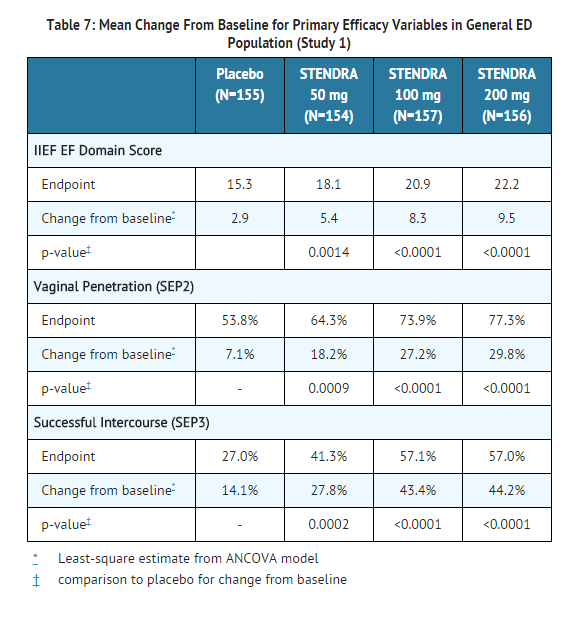
Results in the ED Population with Diabetes Mellitus (Study 2)
Avanafil was evaluated in ED patients (n=390) with type 1 or type 2 diabetes mellitus in a randomized, double-blind, parallel, placebo-controlled fixed dose trial of 3 months in duration. The mean age was 58 years (range 30 to 78 years). The population was 80.5% White, 17.2% Black, 1.5% Asian, and 0.8% of other races. The mean duration of ED was approximately 6 years. In this trial, avanafil at doses of 100 mg and 200 mg demonstrated statistically significant improvement in all 3 primary efficacy variables as measured by the erectile function domain of the IIEF questionnaire; SEP2 and SEP3 (see TABLE 8).
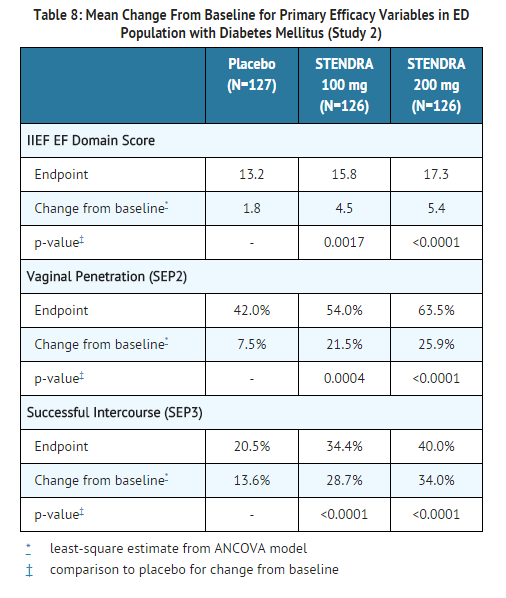
Time to Onset of Effect (Study 3)
- Avanafil was evaluated in 440 subjects with ED including diabetics (16.4%) and subjects with severe ED (41.4%) in a randomized, double-blind, parallel, placebo-controlled study of 2 months duration. The mean age was 58.2 years (range 24 to 86 years). The population was 75.7% White, 21.4% Black, 1.6% Asian, and 1.4% of other races. Subjects were encouraged to attempt intercourse approximately 15 minutes after dosing and used a stopwatch for measurement of time to onset of effect, defined as the time to the first occurrence of an erection sufficient for sexual intercourse.
- Avanafil 100 mg and 200 mg demonstrated statistically significant improvements relative to placebo in the primary efficacy variable, percentage of all attempts resulting in an erection sufficient for penetration at approximately 15 minutes after dosing followed by successful intercourse (SEP3) (see TABLE 9).
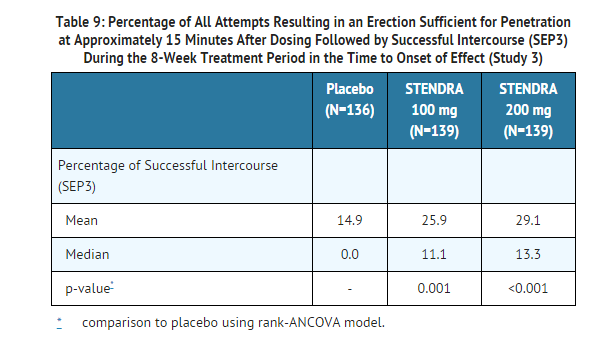
How Supplied
- STENDRA (avanafil) is supplied as oval, pale yellow tablets containing 50 mg, 100 mg, or 200 mg avanafil debossed with dosage strengths.
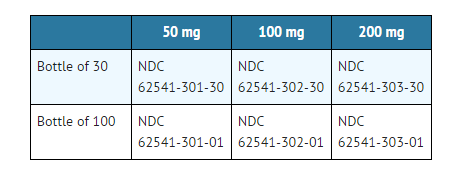
Storage
- Recommended Storage: Store at 20-25°C (68-77°F); excursions permitted to 30°C (86°F) [see USP Controlled Room Temperature].
- Protect from light [see USP Controlled Room Temperature].
Images
Drug Images
{{#ask: Page Name::Avanafil |?Pill Name |?Drug Name |?Pill Ingred |?Pill Imprint |?Pill Dosage |?Pill Color |?Pill Shape |?Pill Size (mm) |?Pill Scoring |?NDC |?Drug Author |format=template |template=DrugPageImages |mainlabel=- |sort=Pill Name }}
Package and Label Display Panel
File:Avanafil image.jpg {{#ask: Label Page::Avanafil |?Label Name |format=template |template=DrugLabelImages |mainlabel=- |sort=Label Page }}
Patient Counseling Information
Nitrates
- Physicians should discuss with patients the contraindication of avanafil with regular and/or intermittent use of organic nitrates. Patients should be counseled that concomitant use of avanafil with nitrates could cause blood pressure to suddenly drop to an unsafe level, resulting in dizziness, syncope, or even heart attack or stroke.
- Physicians should discuss with patients the appropriate action in the event that they experience anginal chest pain requiring nitroglycerin following intake of avanafil. In such a patient, who has taken avanafil, where nitrate administration is deemed medically necessary in a life-threatening situation, at least 12 hours should elapse after the last dose of avanafil before nitrate administration is considered. In such circumstances, nitrates should still only be administered under close medical supervision with appropriate hemodynamic monitoring. Patients who experience anginal chest pain after taking avanafil should seek immediate medical attention.
Cardiovascular Considerations
- Physicians should discuss with patients the potential cardiac risk of sexual activity in patients with preexisting cardiovascular risk factors. Patients who experience symptoms upon initiation of sexual activity should be advised to refrain from further sexual activity and should seek immediate medical attention.
Concomitant Use with Drugs Which Lower Blood Pressure
- Physicians should advise patients of the potential for avanafil to augment the blood pressure-lowering effect of alpha-blockers and other antihypertensive medications.
Potential for Drug Interactions
- Patients should be advised to contact the prescribing physician if new medications that may interact with avanafil are prescribed by another healthcare provider.
Priapism
- There have been rare reports of prolonged erections greater than 4 hours and priapism (painful erections greater than 6 hours in duration) for this class of compounds. Priapism, if not treated promptly, can result in irreversible damage to the erectile tissue. Physicians should advise patients who have an erection lasting greater than 4 hours, whether painful or not, to seek emergency medical attention.
Sudden Loss of Vision
- Physicians should advise patients to stop use of all PDE5 inhibitors, including avanafil, and seek medical attention in the event of a sudden loss of vision in one or both eyes. Such an event may be a sign of non-arteritic anterior ischemic optic neuropathy (NAION), a cause of decreased vision including permanent loss of vision that has been reported rarely in temporal association with the use of PDE5 inhibitors. It is not possible to determine whether these events are related directly to the use of PDE5 inhibitors or to other factors. Physicians should discuss with patients the increased risk of NAION in individuals who have already experienced NAION in one eye. Physicians should also discuss with patients the increased risk of NAION among the general population in patients with a "crowded" optic disc, although evidence is insufficient to support screening of prospective users of PDE5 inhibitor, including avanafil, for these uncommon conditions.
Sudden Hearing Loss
- Physicians should advise patients to stop taking PDE5 inhibitors, including avanafil, and seek prompt medical attention in the event of sudden decrease or loss of hearing. Use of PDE5 inhibitors has been associated with sudden decrease or loss of hearing, which may be accompanied by tinnitus and dizziness. It is not possible to determine whether these events are related directly to the use of PDE5 inhibitors or to other factors.
Alcohol
- Patients should be made aware that both alcohol and PDE5 inhibitors including avanafil act as mild vasodilators. When mild vasodilators are taken in combination, blood pressure-lowering effects of each individual compound may be increased. Therefore, physicians should inform patients that substantial consumption of alcohol (e.g., greater than 3 units) in combination with avanafil can increase the potential for orthostatic signs and symptoms, including increase in heart rate, decrease in standing blood pressure, dizziness, and headache.
Sexually Transmitted Disease
- The use of avanafil offers no protection against sexually transmitted diseases. Counseling of patients about the protective measures necessary to guard against sexually transmitted diseases, including Human Immunodeficiency Virus (HIV) should be considered.
Recommended Administration
- Physicians should discuss with patients the appropriate use of avanafil and its anticipated benefits. It should be explained that sexual stimulation is required for an erection to occur after taking avanafil. Patients should be counseled regarding the dosing of avanafil. Inform patients that the recommended starting dose of avanafil is 100 mg, taken as early as approximately 15 minutes before initiating sexual activity. Based on efficacy and tolerability, the dose may be increased to 200 mg taken as early as approximately 15 minutes before sexual activity, or decreased to 50 mg taken approximately 30 minutes before sexual activity. The lowest dose that provides benefit should be used. Patients should be advised to contact their healthcare provider for dose modification.
Precautions with Alcohol
- Alcohol-Avanafil interaction has not been established. Talk to your doctor about the effects of taking alcohol with this medication.
Brand Names
- STENDRA ®[1]
Look-Alike Drug Names
There is limited information regarding Avanafil Look-Alike Drug Names in the drug label.
Drug Shortage Status
Price
References
The contents of this FDA label are provided by the National Library of Medicine.
{{#subobject:
|Label Page=Avanafil |Label Name=Avanafil11.png
}}
{{#subobject:
|Label Page=Avanafil |Label Name=Avanafil11.png
}}